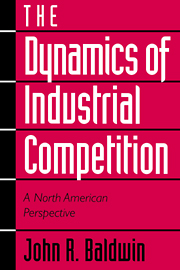Book contents
- Frontmatter
- Contents
- preface
- Acknowledgements
- 1 The dynamics of competition
- 2 Greenfield entry and closedown exit
- 3 Entry, exit, and the merger process
- 4 The rise and fall of incumbents
- 5 Patterns of large- and small-firm mobility
- 6 Plant turnover in Canada and the United States
- 7 Measures of market structure and the intensity of competition
- 8 The relationship between mobility and concentration
- 9 Turnover and productivity growth
- 10 Merger success
- 11 Turnover in domestic and foreign enterprises
- 12 Industry efficiency and firm turnover in the Canadian manufacturing sector
- 13 Firm turnover and profitability
- 14 Modelling entry
- 15 Conclusion
- Appendix A Measuring firm turnover – methodology
- Appendix B Definition of concentration and mobility measures
- Notes
- References
- Author index
- Subject index
6 - Plant turnover in Canada and the United States
Published online by Cambridge University Press: 30 March 2010
- Frontmatter
- Contents
- preface
- Acknowledgements
- 1 The dynamics of competition
- 2 Greenfield entry and closedown exit
- 3 Entry, exit, and the merger process
- 4 The rise and fall of incumbents
- 5 Patterns of large- and small-firm mobility
- 6 Plant turnover in Canada and the United States
- 7 Measures of market structure and the intensity of competition
- 8 The relationship between mobility and concentration
- 9 Turnover and productivity growth
- 10 Merger success
- 11 Turnover in domestic and foreign enterprises
- 12 Industry efficiency and firm turnover in the Canadian manufacturing sector
- 13 Firm turnover and profitability
- 14 Modelling entry
- 15 Conclusion
- Appendix A Measuring firm turnover – methodology
- Appendix B Definition of concentration and mobility measures
- Notes
- References
- Author index
- Subject index
Summary
This book focuses on the nature of the competitive process. Canada was chosen to illustrate how this process functions because a unique database permits analyses that are not possible for most other countries. The Canadian experience should not, however, be regarded as atypical. To illustrate this point, this chapter focuses on the extent to which competition in the United States is similar to that in Canada. It compares the dynamics of growth and decline in the two countries’ manufacturing sectors by measuring the rate of job growth among entrants and growing plants, and the rate of job destruction among exits and declining plants.
In the past, industrial economists have used international comparisons to examine the connection between market size and firm or plant size. Other studies have examined the extent to which international differences in concentration are rooted in production technology or are related to differences in market size.
The difference in the sizes of Canadian and U.S. markets, along with other factors such as tariff protection, have long been cited as reasons for differences in the intensity of competition. Considerable Canadian research, therefore, has focused on the connection between smaller markets, openness to trade, and the effects of oligopolistic coordination operating behind tariff barriers (Hazledine, 1990). These studies have focused on the determinants of price differences (Hazledine, 1980), differences in scale and diversity (Baldwin and Gorecki, 1987a), and differences in productivity (Caves et al., 1980; Baldwin and Gorecki, 1986a). The current comparison of the differences in job creation and destruction that are captured by turnover measures provides a dimension that has not previously been examined.
- Type
- Chapter
- Information
- The Dynamics of Industrial CompetitionA North American Perspective, pp. 119 - 152Publisher: Cambridge University PressPrint publication year: 1995
- 1
- Cited by



